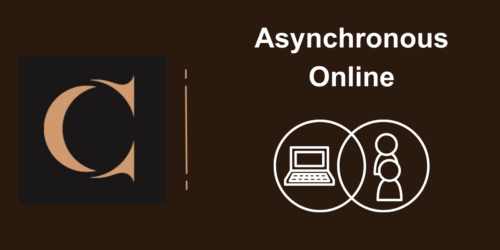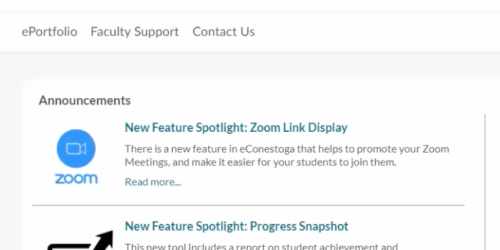Engaging Students as Fully Online Learners
- Why does engaging students in asynchronous online courses matter?
- When and how can fully online learners be engaged in an asynchronous online course?
- How can my fully online teaching engage students more effectively?
Based on recent literature on asynchronous course delivery and advice from the OLC’s Teaching expectations page and Manager, Instructional Design, Marcia Chaudet, this teaching tip provides information about student engagement and ideas for engaging with your students during their anytime, self-directed learning.

Student engagement is faculty-student interaction, and it can also be defined as students interacting with the course content and other students as well (Moore, 1989). Student engagement builds rapport, helps students feel supported, and opens lines of communication when students need clarification or help (Leslie, 2019).
Students must develop self-motivation and self-directed learning skills for success in asynchronous learning, but this takes time and practice. By engaging with students early and often, you help them to build those skills.
Here are some ideas for early and frequent engagement and communication ideas that will help online students feel that that are regularly interacting with you in your asynchronous course.
Engage Fully Students Early
- Post a warm, brief welcome in Announcements. Introduce yourself using the Video Note tool (a recording tool in D2L). Invite students to connect with you!
- Give a brief icebreaker in Discussion or using a web-based tool to allow students get to know each other. It’s a good idea to participate as well!
- Share information about services and resources that support students, including Conestoga-licensed tools such as Grammarly. Pre-created information about these resources are available at this link: Easy Ways to Promote Conestoga’s Student Success Services.
- Describe your communications guidelines, in which you clearly identify what is expected of students and how they can reach you (see below for more).
- Discuss academic integrity, and check to ensure students understand. Remind students to complete Conestoga 101 if it is their first term. Share resources about academic integrity, such as the Conestoga Library’s Student Supports for Academic Integrity to minimize cases of academic dishonesty (Holden, Norris, & Kuhlmeier, 2021).
- Establish a Course Q&A in the Discussion forum. Check for questions answer them regularly. If students message you privately, post as a general question and answer yourself!
Engage Fully Students Often
- Provide regular email or video messages that orient students to where they are in the course, connecting what they have learned to what is coming up next.
- Create announcements that share course-related current events, industry news, tech tools, video examples, etc. You may also wish to include occasional notes of encouragement and celebration, or reflection questions that can help your students to see the course content in new ways.
- Provide reflection and writing activities that help students to reflect deeply on the course content. Make time in your schedule to respond to their reflections.
- Hold regular synchronous office hours that provide support, examples, and other activities to clarify course content.
- Encourage students to engage with each other as well. Keep a “virtual cafe” in the Discussion forum to allow students to share information and ideas that are important for them.
Support Fully Online Students Who May be Struggling
- Provide check-in surveys that asks students how they are doing: what do they like, what do they want more of?
- Offer check-in synchronous online meetings with students in the course part-way through the term. You can use one of many free online scheduling tools, or Microsoft Bookings, to set up meetings conveniently.
- Reach out to students who have not submitted work. Follow up if you do not hear back. Keep a record of your outreach. Download a series of email templates for students struggling with attendance and engagement to adapt and use.
- Use eConestoga Course Management instructor tools, such as Intelligent Agents and the Progress Snapshot Reporting Tool, to promote engagement and keep track of students who may be struggling in the course.
Establish and Maintain Fully Online Communication Guidelines
Communications guidelines provide clear information to students about how, when, and where you and students will connect with each other. Post your communications guidelines in the Course Information section of your course. Point out your guidelines to students in the first week of classes.
Guidelines may include:
- Ways to communicate, including Discussion forums, emails, text chat, Zoom or Teams meetings, etc.
- Weekly virtual office hours (encourage students to attend, but be reminded that this time should not be used for providing lessons)
- When students can hear back from you (within 48 hours, excluding weekends or holidays), and what to do when there is an interruption due to illness, LMS issues, etc.
- How soon you will provide feedback and grades (typically within one week), and where they can access this information
Check on your course every 48 hours to respond to inquiries, discuss topics, and provide feedback on assessments. Scan submitted assignments as soon as they are due to ensure students have submitted the correct documents.See the Email, Voicemail, and Corporate Calendar policy for more information.
Have another idea? Respond to this post with your additional suggestions for engaging with students in your course!
References
Chaudet, M. (2021, August 20). Effective asynchronous content for hybrid and online courses. Coordinator and Leadership Symposium, Conestoga.
Holden, O.L., Norris, M.E., & Kuhlmeier, V.A. (2021). Academic integrity in online assessment: A research review. Frontiers in Education, 6. https://doi-org.conestoga.idm.oclc.org/10.3389/feduc.2021.639814
Kosak, L., Manning, D., Dobson, E., Rogerson, L., Cotnam, S., Colaric, S., & McFadden, C. (2004). Prepared to teach online? Perspectives of faculty in the University of North CarolinasSystem. Online Journal of Distance Learning Administration, 7(3).
Leslie, H.J. (2019). Trifecta of Student Engagement : A framework for an online teaching professional development course for faculty in higher education. Journal of Research in Innovative Teaching & Learning, 13(2), 149–173. https://doi-org.conestoga.idm.oclc.org/10.1108/JRIT-10-2018-0024
Moore, M. (1989). “Three types of interaction”, in Moore, M.G. and Clark, G.C. (Eds), Readings in Principles of Distance Education, American Center for the Study of Distance Education, University Park, PA, pp. 100-105.
Online Learning Centre, Conestoga College (2021). Teaching Online. https://stuconestogacon.sharepoint.com/sites/OnlineLearningCentre/SitePages/Teaching-Expectations.aspx



